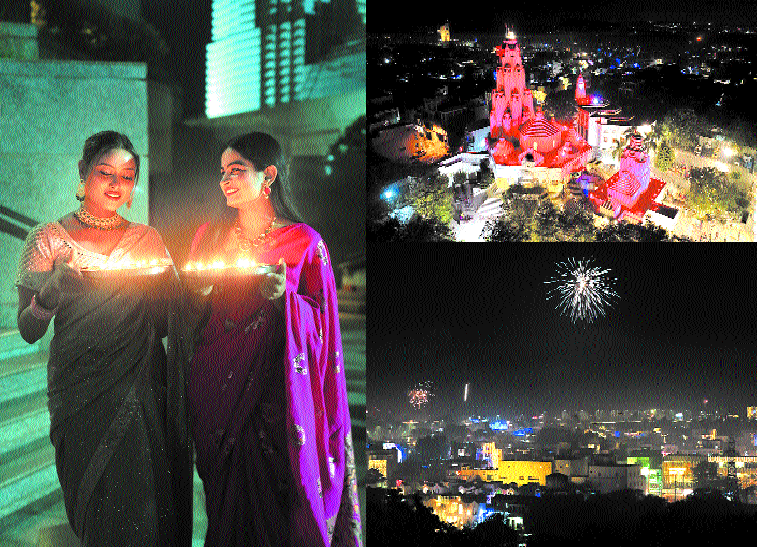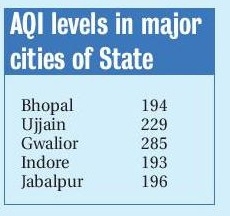AQI reaches to alarming levels in State
| Date :02-Nov-2024 |

Staff Reporter :
As the State celebrated the festival of lights with gaiety, the air quality declined significantly in the region. According to the data released by the Central Pollution Control Board (CPCB), the AQI level in the city soared to 194 with o3 (Ozone) as a prominent pollutant. At many cities, the AQI was in the “poor category” whereas in others, the AQI levels were on the moderate side, with some at the brink of getting a ‘poor’ level.
As reported, Bhopal Municipal Corporation (BMC) had applied a strategy of spraying water in the city in order to control the decline in the air quality during Dussehra. The work was undertaken through sewage jet spray machine. According to the officials at the corporation, during the time of Dussehra, the corporation had incorporated such strategy through the AQI level had come down to 93 on the day of Vijayadashmi. But this time, AQI levels seemed pose a greater challenge to the authorities to control the air quality level.

What haunts citizens even more is the presence of 03 (ozone) in the air. Prior to that, the gas was also found on some occasions. As per information, during summers the gas generally increases in the
environment due to UV rays. Earlier, the gas was found in the air of Indore city near Rajwada area. In May, Bhopal had recorded the presence of the gas for the first time in history.
According to experts, this is something very unsafe for our health and inner body system. Presence of ozone in the air can take lives. Ozone has been mentioned as a prominent pollutant in the list of 12 pollutants marked by the Central Pollution Control Board. Increasing levels of 03 in our environment can be the main reason for heart diseases. Notably, there are three continuous ambient air quality monitoring systems in the city at different places. Daily reading of these systems gets updated on the official websites of the State and Central Pollution Control Board. Notably, the air quality of any place can be measured at six levels. AQI is measured on a scale ranging from 0 to 500.
There are six AQI categories, namely Good (0 to 50), Satisfactory (51 to 100), Moderately polluted (101-200), Poor (201to300), Very Poor (301 to 400) and Severe (401 to 500).
AQI better than
previous year, says BMC
According to BMC officials, this year, on the occasion of Deepawali, the teams of the Municipal Corporation continuously sprayed water last night through sprinklers installed on 21 sewage cleaning vehicles, due to which the Air Quality Index was 176, which was about 133 points or 43 percent less than the Air Quality Index of 309 recorded on the night of Deepawali last year. In compliance with the instructions of Corporation Commissioner Harendra Narayan to do the best
possible work for the cleanliness of the city and environmental protection and improvement of air quality, the sewage cell of the corporation converted 21 sewage cleaning machines into water sprinklers and after the successful experiment done on Dussehra and Dhanteras, this year on Deepawali, water was sprinkled at the main intersections and main places of the city.
Due to the efforts made by the corporation, the air quality index at T.T. Nagar monitoring station established for monitoring air quality was found to be 168 last night which is 46 percent less than the reading of 310 recorded last year. Similarly, the reading at Collectorate monitoring station was 140 which is 55 percent less than the reading of 313 recorded last year and the reading at Paryavaran Parisar station was 221 which is 27 percent less than the reading of 304 recorded last year. This year the average reading was 176 as compared to 309 recorded last year on Deepawali. In this way, the air quality of the city has improved by 43 percent as compared to last year. Such efforts by the corporation will continue. The sewage cell of the corporation sprayed water at major intersections and main places etc. up to a height of about 40 feet with the help of 21 sewage cleaning machines so that the micro dust particles and other pollution causing particles could not float in the air and the air quality improved.
AQI deteriorates to ‘severe’ category
in India cleanest city
Indore,
Nov 1 (PTI)
The Air Quality Index in Indore, the country’s cleanest city, breached the 400 mark on Friday, indicating that the air quality has reached the “severe” category in Madhya Pradesh’s financial capital.
According to the State Pollution Control Board data, the AQI in the city’s Chhoti Gwaltoli area was pegged at 404 at noon, while the PM 2.5 (particulate matter) average was recorded at 255.26. The average level of PM 10 in the city was 318.08.
Chhoti Gwaltoli is a densely populated area of the city that sees heavy vehicular movement.
Dr Dilip Vaghela, an environmental expert and former official of the state pollution control board, told PTI, “The city started with loud Diwali fireworks from Thursday morning which continued till late night. The situation continued in many areas on Friday also. This is the main reason for the air quality in the city reaching the severe category.”
The city’s air quality usually remains in the “satisfactory” (AQI 51-100) category, the expert said.
According to the India Meteorological Department, the wind speed in the city was recorded at zero km per hour at 08.30 am on Friday.
Due to calm winds, pollutants could not get scattered here and there and settled in one place, further worsening the air quality in the city, Vaghela said.
According to a study by Clean Air Catalyst, a global coalition working to improve air quality, vehicular pollution and road dust are the highest contributors (70 per cent) to the deterioration of air quality in the city in normal times. As per the MET Department, an AQI between 0 and 50 is considered ‘good’, 51 and 100 ‘satisfactory’, 101 and 200 ‘moderate’, 201 and 300 ‘poor’, 301 and 400 ‘very poor’, and 401 and 500 ‘severe’.
On the ground, however, Indore has been a model city for waste management. In January, it was ranked as the cleanest city in India for the seventh year in a row under the Centre’s annual Swachh Survekshan Awards.